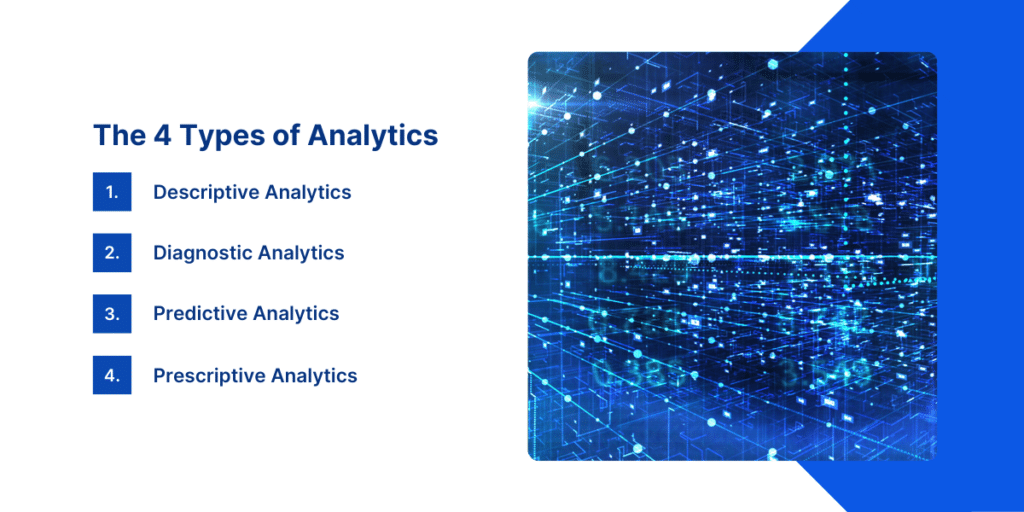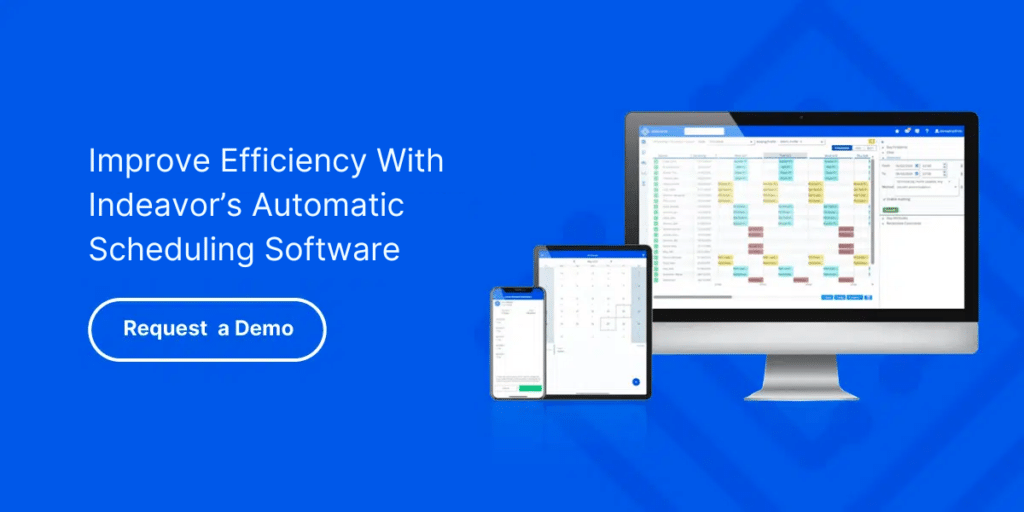Analytics plays a critical role in driving smarter decisions and improving operational efficiency across industries. However, when it comes to workforce management, two types of analytics stand out: Predictive Analytics vs Prescriptive Analytics. Understanding the differences between these two approaches can help organizations optimize their operations, improve labor management, and ultimately boost productivity.
What Are the Four Types of Analytics?
Before diving into the specifics of predictive analytics vs prescriptive analytics, it’s important to understand the four major types of analytics commonly used in data-driven decision-making. Each type serves a distinct purpose, helping organizations gain insights into their past performance, predict future outcomes, and even recommend actions to improve business results.
- Descriptive Analytics – What happened?
- Diagnostic Analytics – Why did it happen?
- Predictive Analytics – What is likely to happen?
- Prescriptive Analytics – What should we do about it?
These four categories work together to form a comprehensive analytics strategy. By understanding how they differ and complement each other, businesses can harness the full potential of their data, whether they’re analyzing what happened, figuring out why it happened, forecasting future events, or determining the best course of action to achieve their goals.
1. Descriptive Analytics
Descriptive analytics focuses on summarizing and interpreting historical data. By examining past performance, businesses can identify patterns, trends, and anomalies. This type of analysis answers the question: What happened?
2. Diagnostic Analytics
Building upon descriptive analytics, diagnostic analytics digs deeper into the reasons behind past performance. It helps answer the question: Why did it happen? This approach is particularly useful for identifying root causes of issues.
3. Predictive Analytics
Predictive analytics, as the name suggests, involves using historical data to predict future outcomes. It leverages statistical models and machine learning algorithms to forecast trends, behaviors, and events that are likely to occur. In workforce management, predictive analytics helps organizations anticipate demand, forecast absenteeism, and predict future labor shortages.
4. Prescriptive Analytics
Prescriptive analytics goes a step further by offering recommendations for the best course of action to achieve desired outcomes. It uses optimization and simulation algorithms to suggest the most effective strategies, helping businesses improve their decision-making. This type of analysis answers the question: What should we do?

What Is Predictive Analytics?
Predictive analytics uses historical data and machine learning models to forecast future outcomes. By analyzing trends and patterns from past events, businesses can make informed predictions about future performance. For example, predictive analytics might be used to forecast labor needs, identify potential supply chain disruptions, or predict customer demand.
As part of the broader predictive analytics vs prescriptive analytics discussion, this type focuses strictly on forecasting—not suggesting actions. According to a study by McKinsey, organizations that use predictive analytics are 2.5 times more likely to make better, faster decisions than their competitors. This powerful tool allows businesses to identify future patterns and potential risks, helping them stay ahead of market changes.
However, despite its growing importance, many companies still struggle to fully leverage its capabilities. This highlights a key opportunity for organizations to integrate predictive analytics more effectively into their decision-making processes, unlocking its full potential to optimize operations and enhance business outcomes.
In workforce management, predictive analytics can be used to:
- Forecast labor demand during peak seasons or promotional periods.
- Predict absenteeism and identify employees likely to call off work.
- Anticipate training needs based on skill gaps or changing workforce trends.
This ability to predict what might happen in the future enables businesses to prepare in advance, make better decisions, and avoid unexpected challenges.
What Is Prescriptive Analytics?
While predictive analytics focuses on forecasting future outcomes, prescriptive analytics takes it a step further by recommending specific actions based on the data. It not only tells businesses what is likely to happen, but it also suggests the best actions to take to optimize results.
The importance of prescriptive analytics is underscored by its growing adoption. A report by IBM reveals that while 70% of business executives rate data science and analytics projects as very important, only 2% believe these projects have fully delivered on their promise. This gap suggests significant room for improvement, where prescriptive analytics could play a pivotal role in bridging the divide between data potential and actual business outcomes.
Prescriptive analytics uses sophisticated algorithms, machine learning, and artificial intelligence to evaluate multiple potential outcomes and recommend the most effective solutions. In workforce management, prescriptive analytics can:
- Optimize employee schedules to meet demand while reducing labor costs.
- Automate decisions around shift assignments, considering factors like employee availability, preferences, and compliance.
- Provide real-time recommendations to managers, enabling quick decision-making during operational challenges.
In essence, prescriptive analytics guides decision-makers toward the best course of action to achieve their business objectives.
Predictive vs. Prescriptive Analytics: What’s the Difference?
While both predictive analytics and prescriptive analytics are essential tools for data-driven decision-making, there are distinct differences between the two approaches.
Focus and Purpose
- Predictive analytics focuses on forecasting future trends, events, and outcomes based on historical data. It answers the question: What could happen in the future?
- Prescriptive analytics, on the other hand, not only predicts future outcomes but also recommends the best course of action to achieve desired results. It answers the question: What should we do to achieve the best outcome?
Data and Techniques Used
- Predictive analytics uses statistical models, regression analysis, and machine learning algorithms to identify trends and forecast future events. It’s all about understanding probabilities and likelihoods.
- Prescriptive analytics employs optimization algorithms, AI, and simulation models to evaluate various scenarios and recommend actionable strategies based on the predicted outcomes.
Actionability
- Predictive analytics tells you what might happen, but it doesn’t tell you what actions to take. It’s a tool for forecasting, not decision-making.
- Prescriptive analytics goes a step further by providing actionable insights and recommendations, making it a tool for decision optimization.
Examples of Predictive and Prescriptive Analytics
To better understand how predictive analytics vs prescriptive analytics work in real-life scenarios, let’s explore some examples in the context of workforce management.
An example of predictive analytics is when a manufacturing plant uses predictive analytics to forecast labor demand for the upcoming quarter. By analyzing historical data, including sales trends, production schedules, and employee attendance, the system can predict how many workers will be needed and when. This allows the plant manager to plan staffing levels in advance, ensuring they are adequately prepared for future demand.
An example of prescriptive analytics is when after predicting labor demand, the prescriptive analytics system recommends an optimized shift schedule that maximizes productivity while minimizing overtime costs. It might take into account employee availability, union rules, and compliance regulations to create the best possible schedule. The system could also make real-time adjustments based on sudden changes in production or employee availability, offering actionable recommendations to managers.

The Difference in Technology Requirements
When comparing predictive vs prescriptive analytics, the underlying technology requirements also differ significantly. This distinction arises because each type of analytics focuses on different aspects of data and decision-making.
While predictive analytics relies on historical data to forecast future trends, prescriptive analytics incorporates real-time data and advanced algorithms to recommend specific actions that optimize outcomes. These differences require varying technological infrastructures, tools, and platforms tailored to the specific needs of each type of analysis.
Predictive Analytics Technology Stack
To implement predictive analytics, businesses typically need access to historical data, statistical modeling tools, and machine learning algorithms. Some key technologies include:
- Data storage systems (e.g., data warehouses, cloud platforms).
- Statistical software or programming languages (e.g., R, Python).
- Machine learning frameworks (e.g., TensorFlow, Scikit-learn).
Prescriptive Analytics Technology Stack
On the other hand, prescriptive analytics requires more advanced technologies due to the need for real-time optimization and decision support. These technologies include:
- Artificial intelligence and machine learning tools to evaluate multiple scenarios.
- Optimization engines and simulation models to recommend the best course of action.
- Real-time data processing platforms to provide immediate recommendations to decision-makers.
Conclusion
In the ongoing debate of predictive analytics vs prescriptive analytics, it’s clear that both types of analytics offer unique advantages. Predictive analytics helps businesses anticipate future trends, while prescriptive analytics goes further by providing actionable recommendations to optimize outcomes. By leveraging both, businesses can unlock powerful insights that drive smarter, more efficient decision-making.
Understanding predictive and prescriptive analytics and their differences allows organizations to select the right tools for their specific needs. Whether you are forecasting labor demand or optimizing employee schedules, these analytics can work together to ensure that your workforce management is data-driven, efficient, and future-ready.
As the landscape of workforce management continues to evolve, adopting predictive and prescriptive analytics will be crucial for businesses looking to stay ahead of the curve. At Indeavor, we offer advanced analytics solutions that help companies improve operational efficiency, optimize workforce management, and achieve better business outcomes. Explore how our solutions can transform your approach to workforce planning and decision-making.
About the Author
Claire Pieper is the Digital Marketing Specialist for Indeavor. In her role, she specializes in crafting strategic and engaging content, ensuring that customers are well-informed. Claire is dedicated to enhancing the customer experience and optimizing the user journey through Indeavor’s solutions. To learn more or get in touch, connect with Claire on LinkedIn.



